Islam in Europe
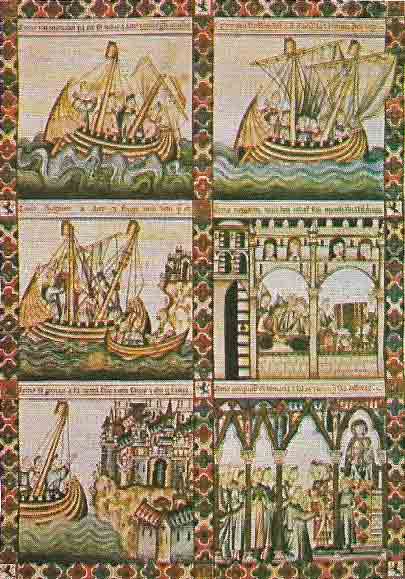
Figure 1. Attributed to Al-fonso the Wise (1221–1284) the Cantigas de Santa Maria is a collection of 400 songs recounting a variety of miraculous and legendary incidents connected with the Virgin Mary. This miniature from a contemporary manuscript depicts the salvation from a storm of merchants bound for Acre, their successful business transactions and the homage they paid to a Marian shrine.

Figure 2. The Great Mosque of Cordoba, begun in the 8th century, was later enlarged and embellished and is a lasting testimony to the magnificence of Islamic civilization in Spain. By 1031 the city had been devastated by civil strife and lost its place of eminence. The mosque survived, was consecrated to Christianity after the reconquest (1236), and had a church built in its center in the 16th century.
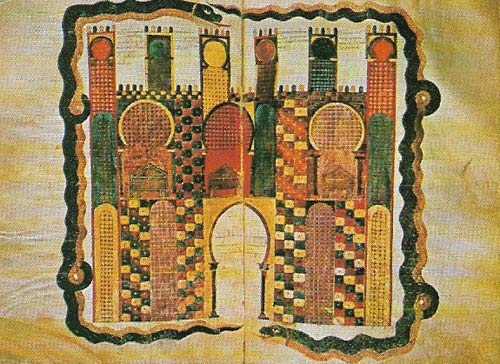
Figure 3. A commentary of the Apocalypse of St John the Apostle by Beatus of Liebana shows one remarkable sided of the culture of Islamic Spain. Christian manuscripts were still copied and studied in monasteries, but their style shows an enormous Islamic influence. Thus in this illumination to the text (which was done at Gerona in about 975) Jerusalem becomes a Mozarabic (Spanish-Muslim) city with the horseshoe arches to the first-floor windows that are the hallmark of the style.
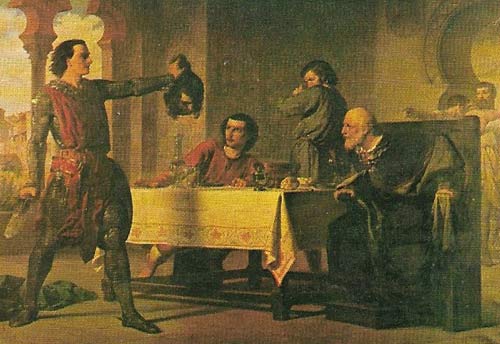
Figure 4. Rodrigo Diaz de Vivar (c. 1043–1099) left, known as "El Cid", was a Castilian knight estranged from the king, Alfonso VI. His exploits were widely celebrated and resemble those of a present-day mercenary. Supported by a force of faithful Castilians he moved freely in Muslim-held territory. His crowning achievement was the capture of Valencia in 1094, which effected his reconciliation with the Castilian kin.
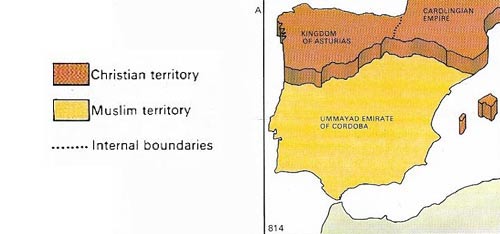

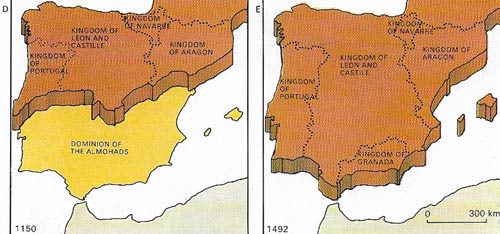
Figure 5. The boundaries between Christian and Muslim Spain altered little until the capture of Toledo (1085).The reconquest achieved its greatest momentum in the 12th and 13th centuries, when the crusading zeal was at its height. The small kingdom of Granada, however, survived until 1492.
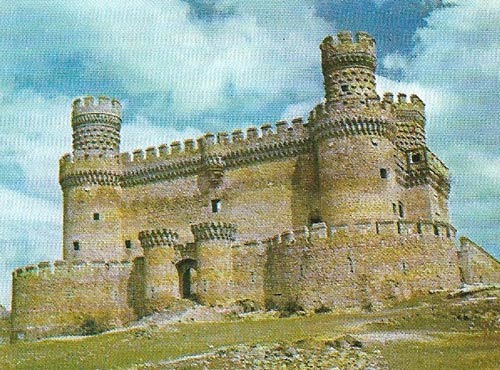
Figure 6. The castle of Manzanares el Real, to the north of Madrid, was constructed near the site of an earlier fortress during the second half of the 15th century in the elaborate Mudejar and late Gothic styles. It was the residence of the Mendoza family, whose members were granted the marquisate of Santillana and the dukedom of Infantado for distinguished political and military service. This brought them material enrichment and increasing prominence in Castile's affairs.
The overthrow of the Visigothic state of Iberia in All 711 by Berber forces recently converted to Islam (further penetration into France was stopped by Charles Martel in 732) was an event unforeseen by the Arabs of the East. The distance of Spain from Damascus was such that these forces could not have expected to enjoy the full fruits of their conquest.
Independence from the East
In the early years the governors of Al-Andalus, as the Muslim-controlled area of the Iberian Peninsula was called, were nominated, however, by the caliphs in the East and revenue from taxation did find its way across the Mediterranean. No such benefits were forthcoming after AD 756 when the Umayyad family achieved pre-eminence among the small number of Arabs (probably fewer than 20,000) who had settled in the peninsula. This family retained supremacy in Cordoba (Figure 2) for nearly 300 years, maintaining from the outset political independence from the East.
Although there was an increasing incidence of conversion to Islam among the indigenous population during that period, the Umayyads of Cordoba could seldom command the loyalty of all Muslims in the peninsula. It was only in the tenth century, under Abd ar-Rahman III, who declared himself caliph in AD 929, that hitherto semi-autonomous regions acknowledged, sometimes after protracted conflicts, the supremacy of the Umayyads. The ensuing unity gave Al-Andalus a strength that enabled the state to brush aside sporadic forays by the kingdoms of the north and even, on occasions, to arbitrate in the dynastic disputes of these kingdoms. Profitable treaties were struck with some of the small North African dynasties and trade was established with the German and Byzantine empires.
Importance of Cordoba
Cordoba became the undisputed capital of western Islam and a magnet for scholars, poets and craftsmen who assembled there from throughout the Islamic world. A palace was built in the cooler foothills of the nearby Sierra Nevada where the caliph resided and conducted affairs of state, while in Cordoba itself successive additions imparted increasing splendor to the Great Mosque.
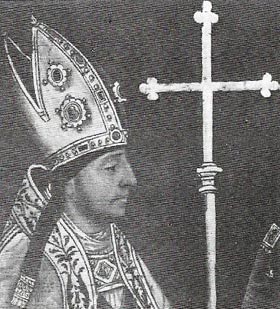 |
| During Raymond of Toledo's archbishopric (1125–1151), large numbers of Arabic works were translated into Latin by scholars from all over Europe. Scientific and philosophical treatises were thus introduced to western Christendom. |
Unity in Al-Andalus proved, however, to be difficult to maintain and as a result the caliphate was formally dissolved in AD 1031. The subsequent fragmentation of Al-Andalus into some 30 city states, all jealous of their own independence and covetous of the territories of their neighbors, occurred in the 11th century when Christians from beyond the Pyrenees, actively encouraged by the pope, became involved in the internal affairs of the northern Spanish kingdoms.
The reconquest of Muslim Spain
The reconquest of Muslim Spain may be considered in two phases, before and after the capture of Toledo in 1085 (Figure 5). Before this date there is scant evidence from Latin or Arabic chronicles that the gradual occupation of territories to their south by the Christian states was either premeditated or concerted. This settling of sparsely populated areas indicated a colonial intention rather than any attempt to wrest territory away from Muslim control and it achieved very little.
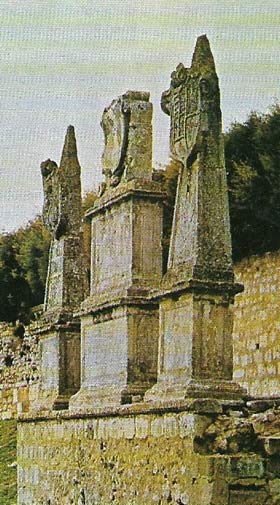 |
| El Cid was born at Vivar, Burgos, where these monuments mark the site of his ancestral home. The Spanish epic Poema de Mio Cid portrays him as a noble Christian hero, loyal to his king despite being banished from the Castile. Arabic sources emphasize his cruelty. Many ballads celebrate his achievements as an invincible knight and it has become difficult to distinguish the Cid of history from the Cid of legend. |
Lack of any effective political cohesion among the Christian states was the main obstacle to territorial expansion at the expense of the Muslims. The Duero and Ebro valleys remained the approximate boundaries until Alfonso VI's definitive occupation of Toledo in 1085 altered the map of the peninsula by placing a permanent Christian wedge in Al-Andalus. From this time the reconquest gathered momentum and the religious factor, hitherto largely dormant, now emerged. The confrontation between Santiago and the Bible for the Christians and Mohammed and the Koran for the Muslims was evident in the clashes between the Almoravids and Almohads, Berber tribes from northern Africa, on the one hand, and the forces of Castile and Aragon on the other.
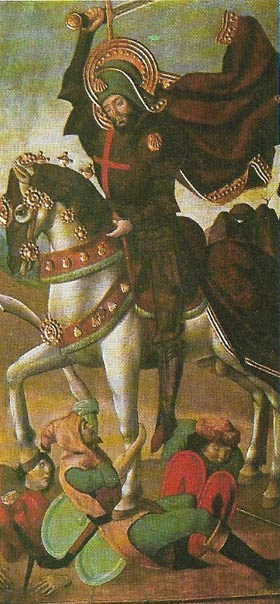 |
| St James the Elder (died c. 44) is the patron saint of Spain. His body was miraculously discovered in the 9th century in the remote province of Galicia where the city of Santiago de Compostela now stands. The shrine became a center of pilgrimage for Christians, thus opening Spain to European influences, and the Spanish Christians acquired a warrior saint who would lead them into battle against the Muslims. |
After suffering reverses, notably at the battle of Alarcos in 1195, the forces of Castile, Aragon and Portugal, usually acting independently of each other, reduced the power of Al-Andalus to some 400 kilometers (250 miles) of coastline from Gibraltar eastwards. The Nasrid kingdom with its capital at Granada lasted 250 years by dint of shrewd diplomacy, judicious alliances contracted from time to time with both Castilians and Muslims from North Africa, trading links with Genoese and Catalan merchants and geographical barriers, such as the Sierra Nevada, that discouraged assaults. The Alhambra, built in the fourteenth century, is the major monument of this bastion of Islamic civilization in a Spain whose political orientation was by then the same as that of the other Western European powers.
Hostility towards the Muslims and reverence for the Islamic cultural tradition were not incompatible in the new Spanish state. While wars were being waged in frontier zones, Toledo, like Norman Sicily, became a center from which Greek and Arabic learning was transmitted to Western scholars. Churches in ornate styles were built by Muslim craftsmen; kings were familiar with Arabic and yet the power of Islam in Spain and Sicily was on the wane. The reconquest was a major political achievement, but the vestiges of nearly 700 years of Islamic presence in Spain were indelible.
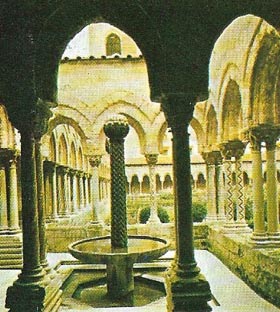 |
| Byzantine and Arabic features are prominent in Monreale Cathedral, built by the Norman William II (1154–1151), large numbers of Arabic works were translated into Latin by scholars from all over Europe. Scientific and philosophical treatises were thus introduced to western Christendom. |
